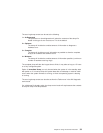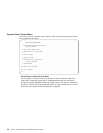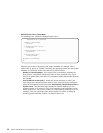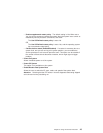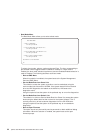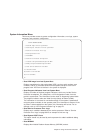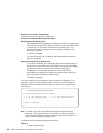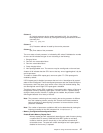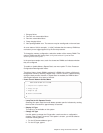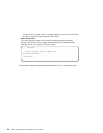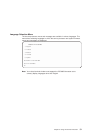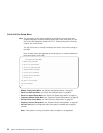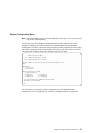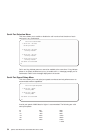Column 2
(0) Logical processor device number assigned by AIX. You can display
these logical device numbers by issuing the following command on the AIX
command line:
lsdev -C | grep proc
Column 3
(3.0) Processor address list used by the service processor.
Column 4
(00) Error status of the processors.
The error status of each processor is indicated by AB, where B indicates the number
of errors and A indicates the type of error according to the following:
1. Bring-up failure
2. Run-time non-recoverable failure
3. Run-time recoverable failure
4. Group integrity failure
5. Non-repeat-gardable error. The resource may be reconfigured on the next boot.
A status of 00 indicates that the CPU has not had any errors logged against it by the
service processor.
To enable or disable CPU repeat gard, use menu option 77. CPU repeat gard is
enabled by default.
If CPU repeat gard is disabled, processors that are in the ″deconfigured by system″
state will be reconfigured. These reconfigured processors are then tested during the
boot process, and if they pass, they remain online. If they fail the boot testing, they
are deconfigured even though CPU repeat gard is disabled.
The failure history of each CPU is retained. If a processor with a history of failures is
brought back online by disabling repeat gard, it remains online if it passes testing
during the boot process. However, if repeat gard is enabled, the processor is taken
offline again because of its history of failures.
Note: The processor numbering scheme used by the service processor is different
from the numbering scheme used by AIX. Consult the AIX documentation
before configuring or deconfiguring a processor to ensure that the correct
processor is selected.
Note: The number of processors available to AIX can be determined by issuing the
following command on the AIX command line: bindprocessor -q
v Memory Configuration/Deconfiguration Menu
Enable/Disable Memory Repeat Gard
Memory repeat gard will automatically deconfigure a quad of memory during
a system boot if a memory DIMM has failed BIST (power-on self-test),
caused a machine check or check stop, or has reached a threshold of
recoverable errors. The quad will remain deconfigured until repeat gard is
disabled or the memory is replaced.
Chapter 3. Using the Service Processor 47



